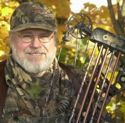During Kentucky’s pioneer era, longhunters and early explorers feasted on buffalo steaks and roasts.
Herds were vast and had a significant impact on the land, grazing down vegetation as they traveled, and creating an extensive network of wide trails throughout the state. Many of Kentucky’s buffalo trails served as primitive roads for early explorers, and eventually became state and federal highways connecting Louisville, Lexington, Frankfort and northern Kentucky.
Explorer Simon Kenton reported seeing more than 1,000 buffalo in the vicinity of Blue Licks Spring, on the south fork of the Licking River, in modern day Nicholas County.

The American bison (Bison bison), a native species in Kentucky, disappeared in the last 30 years of the 18th century, with the last report of a wild herd along the Green River in Hart County about 1820. (Art Lander Jr. Photo)
In far western Kentucky, explorers found a vast grassland, teeming with buffalo, white-tailed deer, eastern elk and wild turkeys, the open lands maintained as “barren” prairies by frequent fires set by native Americans, to discourage woody vegetation and concentrate game.
The American bison (Bison bison), a native species in Kentucky, disappeared in the last 30 years of the 18th century, with the last report of a wild herd along the Green River in Hart County about 1820.
Historic Range
Historians believe bison extended their range as far east as Kentucky, Virginia, Tennessee and the Carolinas, beginning about 10,000 B.C., as a result of over population in the Great Plains.
There are two subspecies, the plains bison, smaller in size and with a more rounded hump, and the wood bison, taller with a square hump.
The bison’s historical range once extended from the boreal forests of Canada’s far northwest, south to Mexico and east to the Atlantic Seaboard. Herds numbered in the tens of millions across the continent.
America’s westward expansion into the grasslands west of the Mississippi River nearly caused the extinction of the plains bison in the 19th century. Herds were decimated through a combination of commercial hunting, shooting for sport, and the introduction of bovine diseases from domestic cattle.
But restoration efforts on public, private and tribal lands saved the buffalo from extinction. Today there are numerous herds on large, private ranches in the West, and at least four free-ranging, genetically-pure herds on public lands.
The largest buffalo herd on public land is on Yellowstone National Park, in Wyoming, Montana and Idaho, where the herd now numbers in excess of 3,500, descendants of some two dozen animals that remained there in 1902.
Buffalo Farming in Kentucky
In Kentucky, buffalo farming has grown steadily in recent decades. Steve Freibert has operated Wooded Ridge Bison Farm, in Port Royal, Ky., in Henry County, for the past 18 years.
He said demand for bison meat has increased by 20 to 30 percent in the last five years, in part because of consumer interest in local foods.
“It’s low fat, low cholesterol, high protein,” said Freibert. “Bison is very filling, and tastes like sweet beef.” Visit his website.
A Look into the Past
A trip to the Elk and Bison Prairie, in western Kentucky’s Land Between the Lakes (LBL), takes visitors back in time to the state’s pre-settlement, when herds of buffalo roamed the vast grasslands in the region.
For more outdoors news and information, see Art Lander’s Outdoors on KyForward.
Native Americans used fire to keep the prairie open, but U.S. Forest Service employees had to clear the land, thin back the trees and deal with fescue, lespedeza, and a lot of exotic plants, to create the 700-acre prairie demonstration area.
The Elk and Bison Prairie is just north and east of the intersection of U.S. 68 and The Trace, the north-south highway which traverses the 170,000 acre national recreation area between Kentucky Lake and Lake Barkley.
It took 10 years to transform an old farmstead back to what the land looked like around 1790. There was remnants of some native grasses, but managers had to plant Indian Grass, Big Bluestem and other native grasses to restore the prairie.
Between 1996 and 2001, elk and bison were returned to the prairie, to eat grass and naturally fertilize the soil. The animals were fitted with ear tags and implants, so biologists can identify individuals and keep up with their health histories.
Early and late in the day is the best time observe them, grazing at roadside. When you drive through the gates you step back into the world that 18th century longhunters saw.
Without heavy grazing, disturbance of the soil, and the annual fires, prairie soon reverted to forest. In just a few short decades, by 1820 in Kentucky, the prairie and the buffalo, were fast becoming a historical footnote.
The Elk and Bison Prairie, in Land Between the Lakes National Recreation Area, is open to visitors year-round, from dawn to dusk. Visitors drive on a 3 1/2-mile road that traverses the 700-acre fenced enclosure, and have excellent opportunities to see and photograph wildlife up close.
For information visit their website.
Art Lander Jr. is outdoors editor for NKyTribune and KyForward. He is a native Kentuckian, a graduate of Western Kentucky University and a life-long hunter, angler, gardener and nature enthusiast. He has worked as a newspaper columnist, magazine journalist and author and is a former staff writer for Kentucky Afield Magazine, editor of the annual Kentucky Hunting & Trapping Guide and Kentucky Spring Hunting Guide, and co-writer of the Kentucky Afield Outdoors newspaper column.























